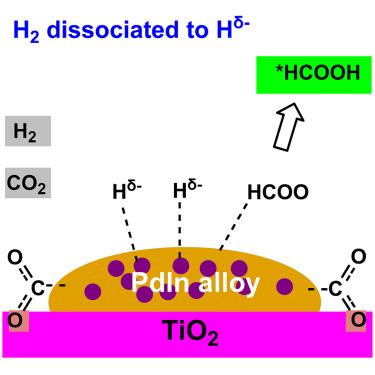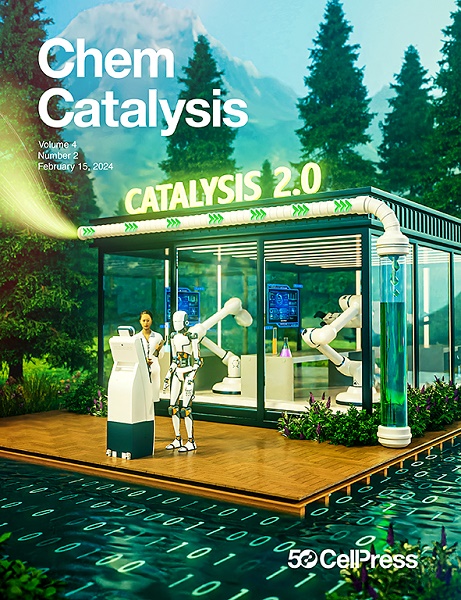Hydrogen dissociation and CO2 activation in cascade CO2 fixation on PdIn/TiO2 catalyst
IF 11.5
Q1 CHEMISTRY, PHYSICAL
引用次数: 0
Abstract
Reduction of CO2 emissions and conversion of CO2 to valuable chemicals is an urgent mission, as it is vital to the global environment and sustainable development. The activation of CO2 is always considered to be the key step for its transformation. Herein, we verified that the activation and dissociation behavior of H2 was the controlling step for CO2 reduction. PdIn alloy was an active center and played a pivotal role in CO2 hydrogenation to the methyl reagent of HCOO∗. H2 split to active Hδ− species on PdIn alloy sites. Strong nucleophilic Hδ− reacted with the CO2 adsorbed on oxygen defects to form ∗HCOO in situ. A high yield of up to 99% was achieved for the cascade fixation of CO2 to valuable amines. The new insights into the activation of CO2 and H2 and their contributions to CO2 conversion that we present will attract the attention of researchers in catalysis, synthesis, surface, and interface chemistry.

PdIn/TiO2 催化剂上级联二氧化碳固定过程中的氢解离和二氧化碳活化
减少二氧化碳排放和将二氧化碳转化为有价值的化学品是一项紧迫的任务,因为这对全球环境和可持续发展至关重要。二氧化碳的活化一直被认为是其转化的关键步骤。在此,我们验证了 H2 的活化和解离行为是二氧化碳还原的控制步骤。PdIn 合金是一个活性中心,在 CO2 加氢为 HCOO∗ 的甲基试剂过程中发挥了关键作用。H2 在 PdIn 合金位点上分裂成活性 Hδ- 物种。强亲核 Hδ- 与吸附在氧缺陷上的 CO2 发生反应,在原位生成 ∗HCOO。在将 CO2 级联固定为有价值的胺时,产量高达 99%。我们提出的关于 CO2 和 H2 活化及其对 CO2 转化贡献的新见解将吸引催化、合成、表面和界面化学研究人员的关注。
本文章由计算机程序翻译,如有差异,请以英文原文为准。
求助全文
约1分钟内获得全文
求助全文
来源期刊
CiteScore
10.50
自引率
6.40%
发文量
0
期刊介绍:
Chem Catalysis is a monthly journal that publishes innovative research on fundamental and applied catalysis, providing a platform for researchers across chemistry, chemical engineering, and related fields. It serves as a premier resource for scientists and engineers in academia and industry, covering heterogeneous, homogeneous, and biocatalysis. Emphasizing transformative methods and technologies, the journal aims to advance understanding, introduce novel catalysts, and connect fundamental insights to real-world applications for societal benefit.

 求助内容:
求助内容: 应助结果提醒方式:
应助结果提醒方式:


